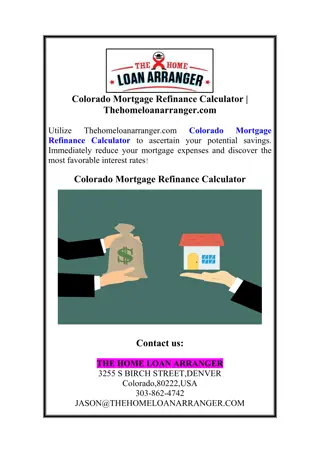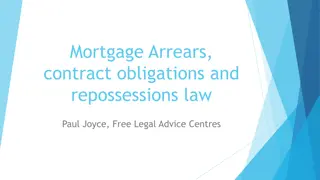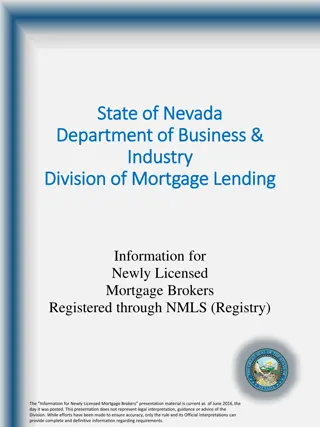Overview of Residential Mortgage Types and Borrower Decisions
This content delves into various types of residential mortgages and borrower decisions, covering topics such as the primary and secondary mortgage markets, 30-year fixed-rate mortgages, prime conventional mortgage loans, FHA mortgages, and other types like purchase money mortgages, piggyback loans, and home equity loans. The information sheds light on different aspects of the mortgage industry, including loan origination, capital supply, loan insurance programs, and property buyer financing options.
Download Presentation

Please find below an Image/Link to download the presentation.
The content on the website is provided AS IS for your information and personal use only. It may not be sold, licensed, or shared on other websites without obtaining consent from the author.If you encounter any issues during the download, it is possible that the publisher has removed the file from their server.
You are allowed to download the files provided on this website for personal or commercial use, subject to the condition that they are used lawfully. All files are the property of their respective owners.
The content on the website is provided AS IS for your information and personal use only. It may not be sold, licensed, or shared on other websites without obtaining consent from the author.
E N D
Presentation Transcript
Chapter 10 Chapter 10 Residential Mortgage Types and Residential Mortgage Types and Borrower Decisions Borrower Decisions Real Estate FIN 331 Fall 2018
Primary and Secondary Mortgage Markets A. The primary mortgage market is the loan origination market B. Numerous institutions supply capital to borrowers C. Mortgage originators can either hold loans in their portfolios or sell them in the secondary mortgage market D. The principal buyers in the secondary mortgage market are Fannie Mae and Freddie Mac
30-Year Fixed Rate Mortgages 1970-2020
Prime Conventional Mortgage Loans Fixed-rate level payment mortgage Over 64% of loans in 2020 were conventional mortgages 1. Compared to 85% IN 2011 Conventional mortgages typically require 20% down (0.80 loan to value) Conforming conventional loan: meets requirements for purchase in secondary markets for Fannie Mae or Freddie Mac Nonconforming Loans 1. Exceed loan limits (currently $417,000 for most areas of the continental US) 2. May require private mortgage insurance (PMI Adjustable Rate Mortgages (ARM): rates reflect changes in lending rates over time A. B. C. D. E. F.
FHA Mortgages (Federal Housing Administration) A. Primary Objective of 1949 Act: provide good housing 1. FHA is a loan insurance program a. Loans made by private lenders b. Mortgage payment includes insurance premiums (included in loan) c. FHA insures 100% of loan and makes payments if borrower defaults d. If foreclosed, title passes to HUD e. Various types of mortgages covered by FHA programs 2. Veterans Administration has similar program
Other Mortgage Types A. Purchase money mortgage: Mortgage given by a property buyer simultaneous with receipt of title 1. Among real estate brokers: refers to a second mortgage loan from a seller to reduce the buyer s down payment (Amounts to installment payments with interest) 2. Among government agencies: any loan that finances a purchase B. Piggyback loan: 1. A second mortgage paired with an underlying 1st mortgage 2. Keeps the 1stbelow 80 percent LTV, thus avoiding required mortgage insurance
Other Mortgage Types C. Home Equity Loans (HEL) 1. Some home equity loans are closed-end, fixed- term loans 2. Mostly open-end or line-of-credit loans (HELOC) 3. Interest is Tax deductible 4. Strength of the house as security provides favorable rate and longer term 5. Usually limited to total mortgage debt (sum of all mortgage loans) of 75% to 80% of value
Other Mortgage Types D. Reverse Mortgage 1. Many older households are income constrained 2. Over 80% own their home 3. Most have little or no mortgage debt 4. Most do not want to sell 5. Converts home equity into income 6. Owners not be forced to move except if owner fails to maintain insurance & taxes 7. Two major problems: a. Owner may outlive cash flows b. Loans may exceed value of home (if property values decline over time)
Other Mortgage Types E. Interest-Only: 1. No amortizing of principal. 2. Frequently involves a balloon payment Sub-Prime Loans 1. Extending credit to high risk borrowers 2. High default rates due to poor or no creditworthiness background checks 3. Serious problems occurred for borrower when rates adjusted (always up) Alt-A Loans 1. Minimal or no down payments 2. Very weak credit scores 3. Bank not required to verify information provided by borrowers 4. The NINJA loans F. G.
Loan Cost Measures A. Annual Percentage rate (APR) 1. APR converts regular interest expense and up- front loan fees into a single equivalent interest expense 2. APR is far superior to interest rate alone in comparing the cost of loans 3. APR has a bias for most applications: a. APR assumes that up-front fees are spread over the full maturity of the loan b. Since most loans are prepaid before maturity, APR will tend to understate the true cost of borrowing when up-front fees are charged 4. Final APR affected by prepayments
Loan Cost Measures A. Motives for Refinancing 1. Lowering loan costs (lower APR) 2. Reduce the term of the loan (30 to 20 or 15 year mortgage) 3. Lower total amount of interest paid 4. Net Benefit = Total Savings Cost of Refinancing 5. Lower rate results in lower interest deduction slightly higher tax due 6. Spread should be ~ 2%: Old new: Recoup costs over 18 to 24 months
Homework Assignment A. A. Key terms: Alt Key terms: Alt- -A Loan, Conforming A Loan, Conforming Conventional Loan, Conventional Conventional Loan, Conventional Mortgage, Fannie Mae, Freddie Mac, FHA, Mortgage, Fannie Mae, Freddie Mac, FHA, GSE, Home Equity Loan, Jumbo Loans, GSE, Home Equity Loan, Jumbo Loans, Primary Mortgage Market, Secondary Primary Mortgage Market, Secondary Mortgage Market, Reverse Mortgage, Mortgage Market, Reverse Mortgage, Subprime Loan Subprime Loan B. B. Study questions: 1, 2, 3, 4, 6 Study questions: 1, 2, 3, 4, 6























